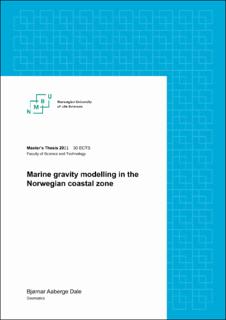| dc.description.abstract | This thesis investigates the possibility of using observations from satellite altimetry in marine gravity modelling. Observations of sea surface height obtained by satellite altimetry can be decomposed into different components, where the Earth's gravity field contribution is among one of those components. By reduction of all other components, a residual geoid height signal can be formed. This residual signal can be used for predicting gravity anomalies by least-squares collocation. The computations are following the remove-compute-restore (RCR)-method where the gravity field's long wavelength components is removed and restored using a global geopotential model. In total,
three global models are used within this thesis: EGM2008, XGM2019e2159 and GOCO06s. The two fi rst models are high-resolution GGMs, while the latter is a satellite-only model with a lower resolution. These different models are selected in order to investigate the assumption about model independence in the RCR-method.
The implementation of lest-squares collocation is validated in an area located approximately 150km from the Norwegian coast. This area is considered to be so far from shore that any coastal effects can be neglected. The validation of least-squares collocation is carried out by comparison with gravity anomalies from a global gravity field model DTU13GRA. The global model is based, to a large extent, on the same data, while the computation method differs, and accordingly the validation procedure is termed as a near closed-loop simulation. Within the validation area, two different mean sea surface models, DTU13MSS and DTU18MSS, are used in the computation of residual geoid height in order to see if any systematic effects can be seen between the different
components.
The prerequisite for applying least-squares collocation is that the residual signal can be treated as a stochastic signal. Empirical covariance functions are used to evaluate the stochastic properties of the residual signal. All residual signals derived by using different GGMs and MSS models result in covariance functions with shapes closely resembling the shape of a stochastic signal. The empirical errors are in mutual agreement between all three models, and hence confi rming the assumption about model independence. When using DTU13MSS the empirical and formal errors are reported as 1.68 - 1.92 mGal and 3.39 - 3.86 mGal, while using DTU18MSS results in 2.23 - 2.35 mGal
and 3.44 - 3.78 mGal. GOCO06s is the global geopotential model resulting best result for both DTU13MSS and DTU18MSS.
Further numerical investigations were performed at a gravimetric testbed formed by the Norwegian Mapping Authority located in the coastal areas outside of Sunnmøre. The empirical errors must be analysed with caution due to degrading quality of DTU13GRA in the coastal areas. Within this testbed the residual geoid height was formed by heterogeneous observations from Saral/ALTIKA, Saral/ALTIKA-GM, Sentinel-3A and Cryosat-2. These satellite missons employ the SAR technique resulting in signi ficantly higher spatial resolution compared to conventional altimetry satellites. Empirical and formal errors by comparison with DTU13GRA is achieved by 4.08 mGal and
5.55 mGal, respectively.
The empirical and formal errors for both study areas are in accordance with results from similar studies. The formal errors represents an upper-bound estimate compared with the empirical errors. Due to time limitations, comparison by an independent set og ship-measured gravity anomalies provided by the Norwegian Mapping Authority is left to be performed. A comparison with ship-measured gravity anomalies is necessary in order to give a final conclusion on error-estimates of satellite altimetry derived gravity anomalies in coastal areas predicted by least-squares collocation | en_US |

